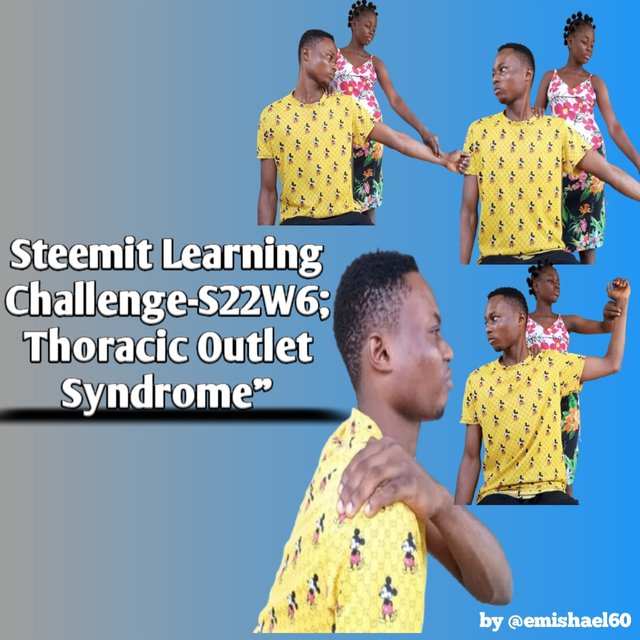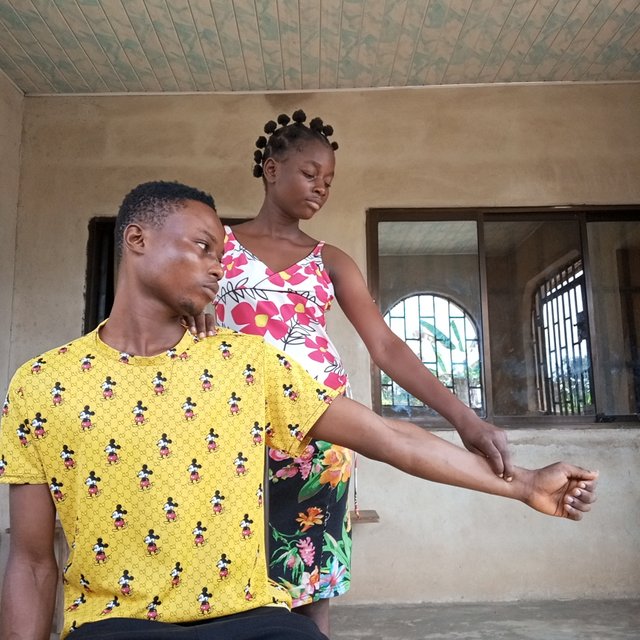Steemit Learning Challenge-S22W6; Thoracic Outlet Syndrome"
 My design on pixellab My design on pixellab |
|---|
Now, suppose you are holding this extremely thick hose of water and everything is good and merely okay, where the water simply goes through it and running out very well. If you somehow bent or stepped on it, then there is a huge chance that this water flow will become slow or just stop at that moment. Why on earth would the water stop!? Because the pressure will build up, after which the hose cannot function freely, or simply properly. Let's see how this will make "Thoracic Outlet Syndrome" understandable ,with the below questions brought to us by @ashkan.....
What's a thoracic outlet syndrome? Write in your own words after getting knowledge from the lesson post. (Note: don't add special tests or investigations and detailed treatment in this question. Write the answer precisely) |
|---|
So let us now return to thoracic outlet syndrome. Think of that space between the collarbone and the first rib as that hose. This so called space- thoracic outlet-.. transmits "blood" same as the hose transmit water. However in this case when nerves or blood vessels is blocked or squeeze-thus stopping it from carrying essential pathways from our chest to our arms; it's like stepping on the hose particularly if these very nerves or blood vessels we talking about get pinched or squeezed, however they won't be able to function well anymore,and that squeezing or pinching is what we called or known as,"Thoracic Outlet Syndrome."
In another words, Thoracic Outlet Syndrome is that very condition involving compression of the blood vessels or nerves in the thoracic outlet. It is described as the passageway between our collarbone and our first rib. This is an important area because it serves as a passageway for nerves and blood vessels that travel from the neck into the arm. Compression of these structures leads to a variety of symptoms which can really impact our everyday life, ruining our day and putting the happiness we had into a stops on enjoying life.
| Causes of Thoracic Outlet Syndrome |
|---|
Well, as we know, anything syndrome or sickness has causes. So, there are a number of causes for TOS, and I would more than be willing to categorize them into three types of causes: anatomical, traumatic, and postural.
Anatomical Causes: Some people have anatomical characteristics that predispose them to developing TOS. For instance, an extra rib (cervical rib) or an excessively tight fibrous band may be compressing nerves and blood vessels of the thoracic outlet.
Traumatic causes: Severe neck and shoulder injuries may also be the cause of TOS. A car injury or a serious sports injury could cause swelling or make structural changes, which may push or compress the thoracic outlet.
Postural Causes: This is where people are seated for too long or slouching. The posture causes tightness of the muscles, shoulder or neck misalignment, and the compression of nerves and blood vessels.
| Types of Thoracic Outlet Syndrome |
|---|
Now we know what has caused it. What about the types?. TOS is normally differentiated into three primary categories based on the compressed structures:.
Neurogenic TOS: However,it is the most common type of; compression of the network of nerves, or called the brachial plexus, through which signals from the spine go to the shoulder, arm, and hand. It can has symptoms including pain, numbness, and weakness in the arm and hand.
Vascular TOS: The subclavian vein is compressed. This causes swelling in the arm and partial discoloration. In extreme cases, one may experience blood clot formation due to an obstruction that causes something to be sticky to the blood.
Arterial TOS: The rarest of all-the subclavian artery in it is compressed. Some of the symptoms include coldness in the arm, pains, and a weak pulse.
| Symptoms of Thoracic Outlet Syndrome |
|---|
Symptoms of TOS vary between the two subtypes and levels of severity but most frequently appear as:
- Pain or ache: It felt in the neck, shoulder, or arm: it could be sharp, throbbing, aching.
- Numbness or tingling: It felt both, in the fingers or hand which can sometimes ache and may create some kind of concern for the ones experiencing them-they may certainly interfere with everyday lifestyle and even daily activities.
- Weakness: Weak grip, without being able to lift.
- Swelling: In vascular TOS, there is swelling of the arm; this is usually accompanied by heaviness.
- Coldness: In arterial TOS, the affected limb may be cooler as compared to the opposite one, with pale or bluish discoloration of the skin.
However, I should say that Understanding TOS is very important, because it will help us to know and recognize its symptoms and seek appropriate help.There is a free book that talk much deep about TOS, click here to get your copy.
How would you diagnose a thoracic outlet syndrome? Any clinical investigation or assessment tests? ( Don't add treatment to this question) |
|---|
| Diagnose |
|---|
Diagnosis of thoracic outlet syndrome usually occurs after an extensive clinical examination. In the case that a specific test or imaging studies have been applied, the final diagnosis is determined upon history and physical examination. Thus, I'd love to diagnose TOS in four ways:.
Patient History: Ask about the symptoms, their onset, and severity, as well as any activities that exacerbate them. Inquire about past traumatic injuries or previous medical conditions that may be contributing to TOS.
Physical Examination: I will perform an examination of his or her posture, neck, shoulder, and arm range of motion and strength. This will also confirm possible signs of nerve compression, which include numbness or weakness in the arm.
Provocation Symptoms: There are some positions or movements which may provoke symptoms, and with that, I can ask the patient to perform certain actions to see if she would reproduce it symptoms. It can help in determining what kind of TOS.
Symptom Observance: There should be an assessment for any swelling, discoloration, or temperature change in the affected arm, as these are sure signs of venous or arterial involvement.
While some imaging studies are generally performed-a normal X-ray of the cervical region, MRI, or ultrasound-as needed to assist in making a diagnosis for associated anatomical defects,of TOS.
Note:proper diagnosis by your physician is needed to devise treatment:.
| Test |
|---|
There are three particular test that can be brought to practice to detect Tos. Here are the three test:-Adson Maneuver, Halstead Maneuver and Allen or Weight Test.
Adson Maneuver

Patient has to sit with the arm at the side and the hand facing anteriorly. First thing is to Check their blood pressure. Then ask the patient to flex the neck to one side and hold it there. They are to take a deep breath and hold it. If their symptoms return, then the test is positive.
Halstead Maneuver

Sit patient down. He or she shall take radial pulse first and should then turn neck towards the other side compared with Adson test. I shall then now pull affected side of patient by the downward path. Once more, pulse needs to be rechecked and then if there exists an alteration within the movement it shall result into a positive of vascular TOS.
Allen or Wright Test

For the Allen or Wright test, the patient is instructed to sit down and elevate the arm overhead, and any alteration in color, temperature, and pulse of the wrist. These changes examine if there has been any compression on the thoracic outlet.
Try to practice at least 3 exercises that you have learned from the lesson. Share images, gifs or videos while practicing preferably gifs or videos. |
|---|
Some specific exercises even reduce the expressions of Thoracic Outlet Syndrome by making postures better, improving flexibility of the thoracic and strengthening muscles around the thoracic. Below are the three I learned.
1.Shoulder Shrugs
How to Do It:
Stand or sit with your arms at your sides.
- Raise your shoulders towards your ears as high as possible.
- Hold for a moment then relax and slowly return your shoulders to the original position.
- Do 10 to 15 repetitions.
2.Shoulder External Rotation
How to do it:
- Stand or sit, with your elbow bent at an angle of 90 degrees toward your body
- Hold a small resistance band or a small dumbbell
- This brings your forearm to face outward, but keeps the rest of the arm closer toward your body.
- Return back to the starting position and repeat 10-15 repetitions on either side.
3.Straight Arm Shoulder Extension
How to Perform:
- Stand on your back with your feet at shoulder-width distance.
- Hold a resistance band or light weight tools like starf or stick with both hands on back of your shoulder.
- Keep your arms straight, pull the band or weight down toward your thighs, engaging your shoulder blades.
- Return to the initial position and do for 10-15 repetitions.
Share your review after performing these exercises either on yourself, a healthy individual or a patient. |
|---|
Shoulder Shrugs Review:
Good to discharge tension in the neck and upper back since trapezius muscles come out to facilitate a better posture. But after I had performed this exercise, I felt a routine discharge of tension around my shoulder region and neck region.
Shoulder External Rotation Review:
Shoulder external rotation is one of the nice exercises for shoulder stability and strength, most especially for an athlete or person with injury in the shoulder. This tends to strengthen rotator cuff muscles. After doing the exercise and some practices, I feel an improvement in shoulder mobility and stability.
Straight arm Shoulder Extension:
This exercise targets the back muscles. It can also help enhance good posture through the use of the back muscles. I felt good stretching in the shoulders and the upper back while doing this exercise, together with the increase of strength in arms. Though I felt weak once it was done. After a few minutes I was feeling my arms and shoulders are building up the strength and stamina.
| In conclusion |
|---|
Thoracic outlet syndrome occurs due to compression of nerves or blood vessels between our collarbone and first rib. It is usually due to poor posture, trauma injuries, and often repetitive motions. The common symptoms are: pain, tingling sensation, and muscle weakness. Neurogenic, vascular and arterial TOS are the three different types of this syndrome. Diagnostic tests used may include Adson, Halstead, and Allen/Wright. Symptoms are relieved with the performance of ,Shoulder shrugs, Shoulder external rotation and Straight arm shoulder Extension. Dear friends lets keep Staying active, and fight any syndrome to keep our smile going 😊.
| I place my invite to:@mhizta,@lunasilver,@ngoenyi to participate. |
|---|
Thanks friends for reading
Cc:
@ashkan
Thank you for understanding the lesson and sharing your assignment; I hope that you will enjoy this week's lesson and try to implement it in your life if you see any such case.
Observations
Task 1 (2.7/3)
You have shared a great knowledge about thoracic outlet syndrome, its symptoms, causes, types and other names. But you misunderstood the 3rd type that is mixed TOS not arterial. Secondly separate the symptoms of vascular and neurogenic TOS for better understanding. A bit more depth require to complete the answer. I appreciate your effort.
Task 2 (3/3)
In the second question, you tell us about how you have to assess a patient by doing physical examination, history taking, and investigations. That's good you add special tests and also explanation of special tests. Excellent.
Task 3 (4/4)
You try the shoulder shrugs, external rotation and extension. You did the shoulder shrugs, external rotation and extension correctly. Always remember to apply heat pack in chronic condition and ice pack in acute condition before performing exercises to relax the muscles and reduce stiffness. I appreciate your efforts.
Overall you made a great attempt to answer all the questions. I appreciate your efforts. Keep learning and try to implement your knowledge to the people suffering from thoracic outlet syndrome or any type of spine issue. Thank you.
Note taken. Thanks for the good grade, I'll keep doing more better.
This post as been promoted on X:
https://x.com/emishael60/status/1882513681742983492?t=hrFlDo1dOWbyyUg1eggAtA&s=19
¡Saludos amigo!🤗
El SDT es más complicado de lo que muchas veces creemos, porque su origen puede estar relacionado con un problema vascular o neurogénico.
Lo sorprendente de todo es que, no solo afecta a las personas que practiquen un deporte donde esa zona esté fuertemente involucrada, sino que al tener una postura incorrecta, también se puede padecer.
Te deseo mucho éxito en la dinámica... Un fuerte abrazo💚